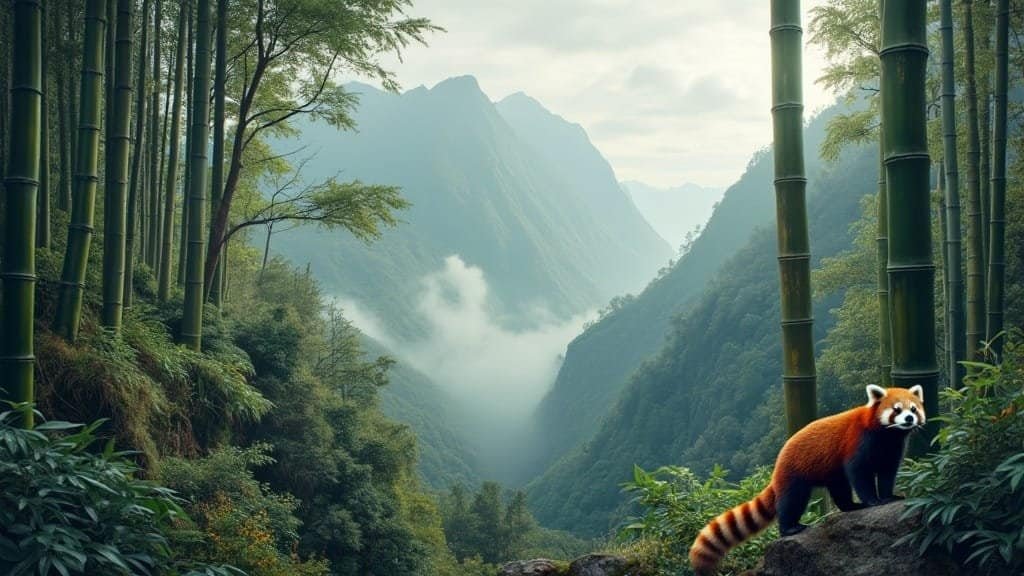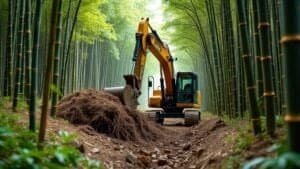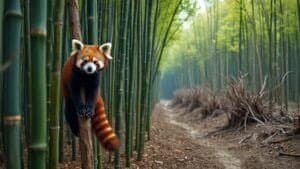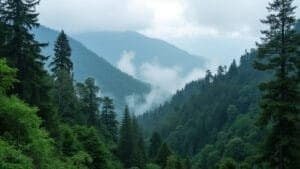Red pandas, elusive and tree-dwelling mammals native to the Eastern Himalayas, are uniquely adapted to life at high elevations. But what is the typical elevation range of red panda habitats? These solitary creatures are generally found in temperate forests with dense bamboo undergrowth, thriving at altitudes between 7,200 and 13,100 feet
This article explores the specific elevation zones red pandas inhabit across countries like Nepal, India, and China. We’ll examine how elevation influences their behavior, diet, and movement patterns, while also detailing the forest types, tree species, and climate conditions that support their survival. Additionally, we’ll delve into elevation-dependent risks like predation and human-driven habitat threats, offering a thorough look at how altitude shapes the red panda’s ecological niche
Typical Elevation Range of Red Panda Habitats

High in the forested mountains of the Eastern Himalayas, red pandas find their ecological niche in cool, bamboo-rich environments. The typical elevation range of red panda habitats falls between 7,200 and 13,100 feet (approximately 2,200 to 4,000 meters). This altitudinal preference is not random—it aligns with the temperature, vegetation, and seclusion that red pandas require to survive
These zones are particularly abundant in dense bamboo thickets and tall trees, both of which are essential to their arboreal lifestyle and specialized diet. Understanding these altitude bands is key to red panda conservation, as habitat degradation at these elevations has direct consequences on the species’ survival
Preferred Altitude Zones in the Eastern Himalayas
Red pandas are distributed across the temperate zones of the Eastern Himalayas, where altitude plays a major role in defining their habitats. Scientific studies, including data presented by Panthi et al. (2011), show that the optimal elevation range where red pandas are commonly sighted lies between 7,200 and 13,100 feet
These elevations offer temperate forest conditions, ideal for sustaining bamboo—red pandas’ primary food source. In Nepal, more than 70% of red panda habitat lies within this band and is primarily outside protected zones, making it vulnerable to human disruption (Red Panda Network, 2024)
The elevation also influences forest composition. These zones are home to a mix of broadleaf and conifer forests, often blanketed in mosses and ferns due to high humidity. This ecosystem complexity allows red pandas to remain hidden from predators, conserve energy, and regulate body temperature in a stable climate. According to Ghose et al. (2015), these elevation-specific conditions reduce thermal stress and allow for energy-efficient locomotion, both essential for a low-calorie bamboo diet
Elevation Range Across Red Panda Range Countries
Across their native range—spanning Nepal, India (particularly Sikkim and Arunachal Pradesh), Bhutan, northern Myanmar, and China (Sichuan and Yunnan provinces)—red pandas are typically found within the same elevation band. However, the specific forest types and conservation statuses vary
In India, they inhabit the Eastern Himalayan broadleaf and conifer forests, mostly above 8,000 feet. In China, they are often found in higher elevations near the edge of subalpine zones, particularly in remote regions of Sichuan that offer both altitude and isolation (Red Panda Network, 2024)
In Nepal, the Dhorpatan Hunting Reserve and Rara National Park represent some of the key habitats within this elevation range, although human encroachment and livestock grazing continue to fragment these areas. Bhutan offers one of the more undisturbed high-altitude red panda environments, where national forest policies protect elevations above 8,000 feet. Red pandas in Myanmar are believed to be more sporadic and harder to monitor, often limited to isolated patches above 7,500 feet
These habitat variations across elevation bands show that while the elevation range remains fairly consistent, the threats and protective measures differ from country to country. This emphasizes the need for localized conservation approaches based on regional elevation profiles
Seasonal Altitudinal Movements of Red Pandas
Seasonal changes prompt red pandas to shift elevation to cope with climate variation and food availability. In the warmer months, they may ascend to higher elevations to take advantage of fresh bamboo shoots and cooler temperatures. During winter, red pandas often descend to lower elevations—sometimes as low as 6,500 feet—to avoid snow cover and reach more accessible bamboo patches. A study by Bista et al. (2023) documented seasonal altitudinal shifts of up to 1,000 feet in some red panda populations within eastern Nepal
This vertical migration is also a response to seasonal fluctuations in thermoregulation needs. Red pandas are highly sensitive to heat and prefer shaded, cool environments. As temperatures rise, they actively seek cooler altitudes with dense canopy cover. Conversely, in cold months, lower elevations provide milder conditions with less snow cover, ensuring easier foraging
These altitudinal shifts are generally limited to a few hundred meters due to the animal’s territorial nature and limited energy reserves. However, with climate change pushing forest lines upward, the availability of suitable elevation zones is shrinking, posing a growing challenge to their seasonal migration strategy
For a detailed look at these elevation preferences, check out this elevation-specific study on red panda habitat use by altitude which highlights empirical data from Nepal’s mountain forests
Environmental and Ecological Factors by Elevation

Red pandas occupy a delicate ecological niche that depends not only on altitude but also on the forest type, bamboo availability, and climatic conditions that change with elevation. These factors directly influence their feeding habits, nesting preferences, and even their long-term survival
The elevation band of 7,200 to 13,100 feet offers a unique convergence of temperate climate, species diversity, and microhabitats that are optimal for red pandas. Understanding how environmental variables shift with elevation is key to assessing the suitability and vulnerability of their habitat across different regions
Forest and Tree Species in Red Panda Ecosystems
Within their preferred elevation range, red pandas inhabit a complex mosaic of forest types. These typically include temperate broadleaf forests, coniferous forests, and mixed forests—each supporting different compositions of trees that define the ecosystem structure and microclimate
At elevations between 8,000 and 11,500 feet in Nepal and Bhutan, forests are often dominated by Himalayan fir (Abies spectabilis), hemlock (Tsuga dumosa), and spruce (Picea smithiana). Mixed with these conifers are broadleaf trees like oak (Quercus spp.), maple (Acer spp.), and rhododendron (Rhododendron arboreum), providing dense canopy cover essential for red panda shelter
These forests support rich understory vegetation, including several bamboo species critical for red panda diet and nesting. Tree canopies provide the vertical structure red pandas need for arboreal movement and protection from predators. Forests at higher altitudes often have a thick growth of mosses, ferns, and lichens, which contribute to overall habitat humidity and insulation during cold seasons
Forest degradation due to human activities—particularly in buffer zones at these elevations—has a cascading effect on tree diversity and forest regeneration. As tree density drops, so does the cover and food reliability for red pandas. According to a 2022 habitat quality study in eastern Nepal, loss of mature oak and fir trees is directly linked to reduced nesting opportunities for red pandas
Bamboo Distribution and Elevation Impact
Bamboo is at the heart of red panda survival, constituting up to 95% of their diet. The availability of bamboo, however, is highly elevation-dependent. Within their optimal elevation range, red pandas feed on various bamboo species including Arundinaria maling, Thamnocalamus spathiflorus, and Yushania maling. These species flourish at elevations between 7,800 and 12,800 feet, with growth patterns that coincide with seasonal temperature changes
At lower elevations, increased human settlement and livestock grazing reduce bamboo cover. Meanwhile, at higher elevations above 13,000 feet, bamboo becomes scarce due to harsh growing conditions, frost damage, and rocky soils. This makes the narrow elevation belt of 8,000 to 12,500 feet the most reliable for year-round bamboo growth
Bamboo’s cyclical flowering and die-off events also challenge red panda survival. In 2014, a mass die-off of Yushania maling in eastern Nepal led to a significant decline in red panda sightings over two consecutive years, according to a Red Panda Network field report. Since bamboo regrowth after flowering can take over five years, it makes red panda populations especially vulnerable in fragmented habitats with limited food alternatives
To better understand bamboo habitat dynamics, you can explore more detailed analysis on the Red Panda Network’s habitat page, which outlines the spatial dependence of red pandas on specific bamboo species
Climate Conditions in High-Altitude Habitats
The high-altitude forests that red pandas inhabit are shaped by a unique set of climate conditions. These areas typically experience mild to cool temperatures ranging from 50°F in spring to just below freezing in winter. Annual temperature variation is relatively low, which helps red pandas avoid thermal stress. High levels of precipitation (often exceeding 60 inches annually) support the growth of moisture-loving bamboo and sustain moss-laden forests
Humidity at these elevations is generally high, particularly in areas with dense canopy and cloud forest influence, like parts of Arunachal Pradesh and northern Myanmar. The frequent fog and mist contribute to a microclimate that promotes moss and lichen growth, enhancing forest floor moisture and creating ideal foraging environments for red pandas
However, climate change is rapidly altering these once-stable systems. With rising global temperatures, the lower limits of red panda habitats are becoming too warm, pushing suitable habitats upslope. A study published in Global Ecology and Conservation (Wang et al., 2023) projected that by 2070, over 35% of current red panda habitat could become unsuitable due to upward forest migration and loss of bamboo growth zones
Long-term shifts in precipitation patterns are also leading to more frequent bamboo flowering failures and drier undergrowth conditions. As elevation buffers shrink, red pandas face greater difficulty in adapting to these changes, especially in areas already stressed by human encroachment
Human Influence and Predation at Various Elevations

Red pandas, while adapted to the tranquil altitudes of the Himalayas, are increasingly impacted by external forces that vary in intensity with elevation. Human activity—ranging from infrastructure development to livestock grazing—and the presence of natural predators both affect red panda survival
These influences are not uniform across the altitude gradient; instead, they present varying challenges depending on the elevation. Evaluating these threats through an elevation-based lens helps in developing targeted conservation responses
Elevation-Dependent Predation Risks
In their high-altitude habitats, red pandas encounter a limited but significant set of natural predators. At elevations between 9,000 and 13,000 feet, the primary predator is the snow leopard (Panthera uncia), a stealthy carnivore with overlapping habitat preferences. Both species use similar forested corridors and prefer areas with dense vegetation, making encounters inevitable
This shared range has been documented through camera trap studies in Bhutan and Nepal, including a notable survey in Langtang National Park where red pandas were observed actively avoiding known snow leopard territories (Panthi et al., 2015)
At lower elevations closer to 7,000 feet, red panda cubs face increased risk from raptors such as owls and eagles, and from smaller carnivores like martens and yellow-throated martens (Martes flavigula). These predators are more common in disturbed or edge habitats, where forest cover is patchy and visibility is higher. Predation pressure thus varies with elevation—less at mid-range altitudes where dense forests offer protection, and more at the upper and lower boundaries where natural or human-induced clearings expose red pandas to risks
Although predation is part of the natural balance, it becomes problematic when coupled with habitat fragmentation. As red pandas are forced into smaller patches of forest due to human activity, their ability to evade predators diminishes, especially in areas where natural hiding spots are reduced
Human Development Impacts on Elevation-Based Habitats
Human-induced pressures on red panda habitats are most intense in the lower and mid-elevation bands, typically between 7,200 and 10,000 feet, where human settlements, roads, and agriculture expand most rapidly. These elevations are not only more accessible but also offer favorable conditions for farming and livestock, bringing human activity directly into red panda territory
Road construction is one of the most significant disruptors. According to a 2023 study by Bista et al. in Oryx – The International Journal of Conservation, red pandas exhibit avoidance behavior within a 300-meter radius of roads. Noise pollution, vehicular movement, and land clearing for roadwork contribute to this displacement. In eastern Nepal, new road networks are often built through mid-elevation forests where red pandas are known to nest and forage, further fragmenting their habitat
Livestock grazing is another pervasive issue. At elevations up to 12,000 feet, herders graze cattle, yaks, and goats, often cutting bamboo for animal bedding and clearing understory vegetation. This practice directly reduces the availability of food and nesting materials for red pandas. Additionally, the presence of dogs accompanying herders introduces another predator threat, as domestic dogs have been recorded killing red panda cubs in buffer zones around protected areas
To read more about these threats and how they are being addressed, visit this in-depth page from the Red Panda Network on habitat threats, which outlines both regional and global conservation efforts
Conservation Challenges Across Elevation Levels
Conserving red pandas requires an elevation-aware strategy. Because red pandas do not roam over large areas, habitat fragmentation—even at a micro scale—can isolate populations and disrupt genetic flow. Lower elevation corridors, which could serve as connectors between highland populations, are often the first to be degraded by human development. Without these links, populations become genetically vulnerable and more susceptible to local extinction events
Higher elevations, while less directly impacted by agriculture or settlement, face the creeping threat of climate change. As temperatures rise, forest lines move upward, but the vertical limit of red panda habitat is finite. Above 13,000 feet, vegetation becomes sparse and unsuitable. This creates an “elevation trap,” where red pandas are pushed to ecological limits without escape routes
Protected areas offer some reprieve, but their effectiveness varies. Many protected zones encompass only specific elevation bands, often missing seasonal migration corridors. Integrating buffer zones and enforcing sustainable land use practices in areas surrounding national parks are critical steps
Additionally, community-based conservation programs have shown success at multiple elevations. In Nepal, the Forest Guardian program trains locals to monitor red panda activity and report threats, helping bridge the gap between remote habitats and centralized conservation planning. Overall, successful conservation of red pandas demands a nuanced understanding of how elevation intersects with human pressures and ecological dynamics—a strategy that balances habitat preservation with community engagement












